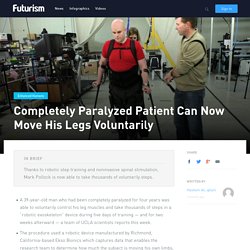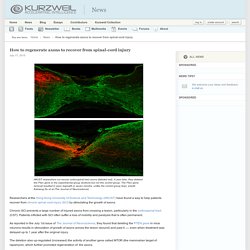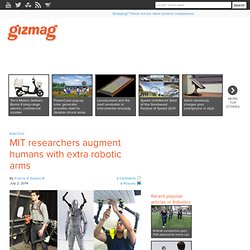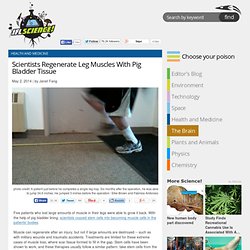

The World's Most Advanced Prosthetic Arm Is Now For Sale. MIT upgrades the human hand with two robotic fingers. A paraplegic learns to walk again without robotic limbs thanks to EEG. Sound Waves May Hold the Key to Faster Computing. In Brief Researchers have found that sound waves can be a faster and low-power alternative to hard disk drives and solid state drives.

Sound Computing A team of researchers from the University of Sheffield and the University of Leeds may have stumbled upon the key to making computers faster. Their recent study has shown that, with minimal use of power, certain kinds of sound waves are able to quickly move data. Currently, a majority of the world’s data is stored and read on magnetic hard disk drives.
Surface Acoustic Waves Now, researchers Dr. In a statement on the University of Sheffield website, Dr. Completely Paralyzed Patient Can Now Move His Legs Voluntarily. In Brief Thanks to robotic step training and noninvasive spinal stimulation, Mark Pollock is now able to take thousands of voluntarily steps.

A 39-year-old man who had been completely paralyzed for four years was able to voluntarily control his leg muscles and take thousands of steps in a “robotic exoskeleton” device during five days of training — and for two weeks afterward — a team of UCLA scientists reports this week.The procedure used a robotic device manufactured by Richmond, California-based Ekso Bionics which captures data that enables the research team to determine how much the subject is moving his own limbs, as opposed to being aided by the device. How to regenerate axons to recover from spinal-cord injury. HKUST researchers cut mouse corticospinal tract axons (labeled red).

A year later, they deleted the Pten gene in the experimental group (bottom) but not the control group. The Pten gene removal resulted in axon regrowth in seven months, unlike the control group (top). (credit: Kaimeng Du et al. 'Cyborg' spinal implant could help paralysed walk again. The implant, called ‘e-Dura’, is so effective because it mimics the soft tissue around the spine – known as the dura mater – so that the body does not reject its presence.

“Our e-Dura implant can remain for a long period of time on the spinal cord or cortex,” said Professor Stéphanie Lacour. “This opens up new therapeutic possibilities for patients suffering from neurological trauma or disorders, particularly individuals who have become paralyzed following spinal cord injury.” Non-Invasive Spinal Cord Stimulation Technique Allows Paralyzed Men to Move Legs Again. Man With Severed Spinal Cord Walks Again After Cell Transplant. A man paralyzed for two years is now walking again, albeit with a frame, after a transplant to his spine.

The treatment, to be published in this month's Cell Transplantation, has been under discussion for a while, but has only now shown success. In 2010, Darek Fidyka was repeatedly stabbed, rendering him paralyzed from the chest down. Fortunately, however, his nose was unscathed. Hugh Herr: The new bionics that let us run, climb and dance. Paralyzed woman walks again with 3D-printed robotic exoskeleton. MIT researchers augment humans with extra robotic arms.
Featured in comic books since 1963, Dr.

Octopus, or "Doc Ock" is an enemy of Spiderman with four extra robotic arms attached to his back that assist him in his nefarious plans. That vision of humans with extra limbs – minus the supervillain part – is taking shape at MIT with researchers adding "supernumerary robotic arms" to assist with tasks that ordinary two-armed humans would find difficult. View all There are many tasks around the house or factory that you have probably said to yourself, “if I only an extra arm, this would be a lot easier. " Tasks like hanging a ceiling fan, installing an overhead light fixture, or even just holding open a box would be easier if there was an extra arm to help out. The project is being run at MIT’s d'Arbeloff Laboratory for Information Systems and Technology and headed by Federico Parietti and Baldin Llorens-Bonilla, both in the Mechanical Engineering Department.
Scientists Grew a Rat Limb in the Lab Scientists Regenerate Leg Muscles With Pig Bladder Tissue. Muscle can regenerate after an injury, but not if large amounts are destroyed -- such as with military wounds and traumatic accidents.

Treatments are limited for these extreme cases of muscle loss, where scar tissue formed to fill in the gap. Stem cells have been shown to work, and these therapies usually follow a similar pattern: take stem cells from the patient, help them develop into the cells of choice, then inject them back. Now, a University of Pittsburgh team led by Stephen Badylak developed a different kind of stem cell treatment that doesn’t involve taking out and adding back stem cells; rather, the stem cells stay in the body. Huge Milestone Crossed: First Person to Feel Physical Sensations Through a Prosthetic Hand. A sensational breakthrough: the first bionic hand that can feel - News - Gadgets & Tech. The patient is an unnamed man in his 20s living in Rome who lost the lower part of his arm following an accident, said Silvestro Micera of the Ecole Polytechnique Federale de Lausanne in Switzerland.

The wiring of his new bionic hand will be connected to the patient’s nervous system with the hope that the man will be able to control the movements of the hand as well as receiving touch signals from the hand’s skin sensors. Dr Micera said that the hand will be attached directly to the patient’s nervous system via electrodes clipped onto two of the arm’s main nerves, the median and the ulnar nerves. This should allow the man to control the hand by his thoughts, as well as receiving sensory signals to his brain from the hand’s sensors. It will effectively provide a fast, bidirectional flow of information between the man’s nervous system and the prosthetic hand. “This is real progress, real hope for amputees. The First Person To Ever Receive Two Mind-Controlled Prosthetic Arms.